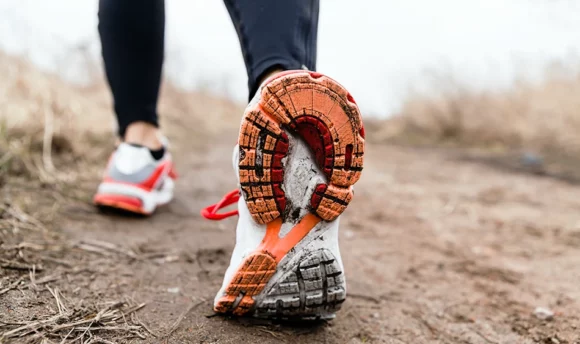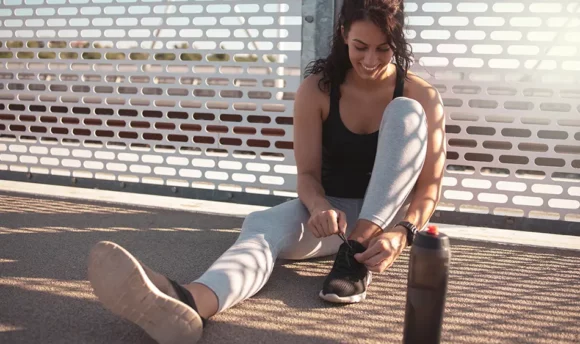Proper Running Form: 10 Tips and Techniques for Beginners
Have you ever felt you could do more with your running exercises if only you had the proper running form? Today, we discuss the proper running form and how you can develop it. Stay tunned!

As a runner, being able to take on more challenges and run faster and more efficiently over long distances is a dream come true.
However, for that to happen, you are required to have different tools readily at your disposal. And for that, you need to train consistently. One such tool is the proper running technique.
Using the proper running form helps you become an efficient runner. With the correct running technique, you can conserve energy, stay injury free, and run faster and longer distances with less effort. But what does all of this mean?
What is a proper running form, why it matters, and how can you even it out?
What Is a Proper Running Form?
Experts define proper running form as stacking your body straight while moving. That means your upper and lower body all fall in one straight line. For your running form to be considered proper, each body system stacked on top of each other must be neutrally tilted.
However, you should know that there is no sole running form – it differs from person to person. As such, you need to familiarize yourself with the mechanics of a good running technique. That way, your runs are highly energy-efficient and comfortable.
Aspects of a proper running form
While there is a level of individuality to a proper running form – to each his own – there are certain aspects that remain standard. Essentially, there is a way you should run, and here is the blueprint:
- Lean slightly forward
- Look ahead
- Keep shoulder blades neutral
- Bend elbows around 90 degrees
- Stabilize the core
- Lift and flex the knee
- Push off the back leg
What Are the Techniques of Running?
When it comes to running, there are 2 forms: sprinting and jogging. Both workouts host several differences, with the primary difference being speed.
Sprinting is an intense form of running involving going at high speeds, with the goal being to cover as much ground as possible in a short time.
On the other hand, jogging is slower and steadier, making it better for longer distances where you need to conserve your energy but still be able to run without too many breaks or transitions in between.
However, this difference between the workouts introduces a slight deviation in the required running form.
In line with that, we shall look at the form required for both workouts.
Sprinting
Here is how to maximize your sprinting workouts.
- You want to keep your core engaged. You will have a slightly forward lean, but that is natural.
- Lift your chest and draw your shoulders away from your ears, keeping them relaxed at all times.
- Employ short, fast steps to avoid using more energy. For example, keep your landings light to reduce your risk of injury.
- Use the forefoot strike to propel yourself forward. Next, lift your thigh to make it parallel to the ground.
- Keep your elbows at a 90-degree angle and draw them straight back, then forth, as if you were stretching. This will help keep the reciprocating motion in check so that it can be labored and easy for yourself!
- Raise your arms forward, all the way to your chin, and bring it as far back as your lower back.
- Try to match your arm and leg movement. Your arm swing should match your leg movement (the left foot goes with the right arm and vice versa).
- For a good posture, it’s important not to rotate your torso and bring your arms across the midline of your body.
Jogging
Here is how to maximize your jogging workouts.
- You want to keep your core engaged while locking your gaze forward.
- Keep your head and shoulders straight.
- Lift your chest, keep it broad, and pull your shoulders back and down.
- Keep your hands loose and use a relaxed arm swing. Avoid crossing them in front of you or pulling up tight against your body as you swing forward.
- Use the midfoot strike to propel yourself (avoid landing on your heel).
Whether running (sprinting or jogging) outside or on a treadmill, the technique remains the same, however, if this is a tad tricky, the solution is to consult the Joggo running app.
Joggo’s fitness app is a personalized running app that offers continuous assistance and support throughout your fitness journey. In addition, it features a mix of running workouts and meal plans tailored to all levels of runners.
Joggo’s all-in-one fitness app also features easy-to-follow audio-guided training. That way, you can easily follow through warm-ups, correct breathing and posture-keeping techniques, stretching, and cool-down routines.
You can incorporate the app’s techniques and routines into your existing training plan, making it one of the best workout additional tools available.
10 Tips to Keep a Proper Running Form
Maintaining a proper running form requires continuous, conscious effort. Therefore, working on your own running form is vital as it helps improve running efficiency.
Experienced runners have mastered the proper running form, understanding body mechanics, running technique, and what it takes to be efficient runners.
However, if you are a less seasoned runner, you might wonder, “How do I get a proper running form, and how do I keep it?”
Here is your answer: 10 tips to keep a proper running form.
#1 Understand physical tensegrity models
When we move, parts of our body tense and relax. Imagine the body as a sailboat: pulling on specific ropes makes it drive forward while leaving others loose, causing movement to occur at different speeds based on how much wind there is in each area.
This idea resembles muscle tension when running – some groups get taut due to their use needed for stability, like glute tightness, versus those who offer less assistance, such as neck muscles.
Relaxation helps us maintain energy levels during faster movements so they can last longer without fatigue.
#2 Develop your running posture
Ensure you are not slouching as you run to avoid lower back pain! Keep an upright posture with the chest out and shoulders under the ears.
Maintaining a neutral pelvis is also essential for runners who want better performance outcomes. Avoid leaning forward or backward at the waistline when tired after workouts.
Doing this can lead to other problems, like sciatica nerve irritation, which causes shooting sensations down one leg due to poor alignment in the hips
#3 Do a gait analysis
A gait analysis can help you identify ineffective movement patterns that may be causing you to run inefficiently or place unnecessary stress on your body. Correcting these issues can improve your running and reduce your risk of pain or injuries.
Typically, a gait analysis will involve being filmed while running on a treadmill or ground. A qualified coach or therapist will then analyze the footage to identify any issues with your technique.
Afterward, you should focus on correcting your gait to get a correct running form, and you can do this using a series of different exercises.
#4 Learn to engage your core
The core muscles are essential for maintaining good posture and can be strengthened through specific exercises. In addition, one of the benefits of engaging the core muscles is that it helps to stabilize the spine.
This is important because the force of impact when running can put a lot of stress on the spine, and a strong core can help to absorb some of that impact. Additionally, engaging the core helps keep the body in alignment and avoid that forward swing motion, minimizing strain on the knees and hips.
When the body is properly aligned, runners can move more efficiently and with less effort. As a result, learning to engage the core muscles is integral to developing good running form.
#5 Know what foot strike to use
There are 3 types of footstrikes: forefoot, midfoot, and heel strike. Learning to take advantage of all three will be helpful as they allow you to navigate through different terrains.
Different foot strikes can be more or less effective depending on the runner’s goals. For example, heel strikes may be more efficient for long-distance runners, while forefoot striking may be better for sprinting.
However, different foot strikes will put different stress levels on other body parts, so it’s essential to find the one that works best for you. Experiment with different footstrikes and pay attention to how your body feels after each one.
#6 Keep an even stride length
Proper stride length is one of the most critical factors in developing good running posture. When your stride is too short, your body compensates by over-rotating, leading to joint pain and other problems.
Conversely, if your stride is too long, you will end up over-striding and wasting energy. The key is finding the balance between the two. If you can maintain a consistent stride length, it will help you run more efficiently and prevent injuries.
There are a few ways to find your ideal stride length. One method is to have someone film you from the side as you run, then analyze your form. Another is to use a GPS watch or app to track your pace and distance.
Experiment with different stride lengths and see what feels best for you. With a bit of practice, you will find the perfect stride length for optimal running posture.
#7 Establish proper breath control
Proper breath control is essential for developing good running posture. When we run, our muscles generate a lot of heat; if we don’t breathe properly, that heat can build up and cause fatigue.
Good breath control helps keep our muscles from overheating and allows us to maintain good form. In addition, our respiratory system is designed to work in tandem with our skeletal system, and when we breathe properly, it helps to support our bones and joints.
Lastly, breathing deeply and rhythmically helps to relax our muscles and prevents us from getting tense. As a result, proper breath control is an essential element of good running posture.
#8 Keep a forward head posture
One of the most common running mistakes is staring at one’s feet. Unfortunately, runners who do this often have a forward-leaning posture which puts excessive strain on their neck and shoulders, causing them pain after long runs or races.
To avoid these problems, focus 10–20m ahead while maintaining an upright posture. Do not forget your arm swing, either – they should move smoothly alongside you without stiffening as though you are lifting weights, which isn’t ideal.
When chasing scenery during fast-paced workouts, it may be difficult to judge the speed accurately, so try varying amounts each step.
#9 Avoid bouncing
Most runners have a high turnover rate, meaning they land and push off with each foot strike.
To increase this in your running style, try shortening the time between heel hits or adding an extra hop before pushing off on shorter distances – that way, both energies are used effectively instead of just relying solely upon one side for power.
#10 Get a good running shoe
Running with a bad running shoe will adversely affect your posture and running performance. However, knowing when to get a new running shoe is a blessing in disguise. Proper running shoes are meant to be bouncy and comfortable as they help with impact absorption.
This allows you to maintain balance as you stride along the pavement, keeping your posture intact and helping prevent injuries.
FAQS
Yes, having a good running form when running can help reduce back pain significantly.
Yes, with a proper running form, you get a significant increase in pace.
A Word From Our Coach
At the end of the day, proper running form translates to sustainable running. But, there is no one-size-fits-all regarding good running form – what works for you may not work for someone else.
A smart way to go about fixing your bad running form is to seek the guidance of a certified coach or physical therapist who can help assess your technique.
Another thing to consider is warm-up and cool-down exercises. Warming up helps to prepare your body for exercise by gradually increasing your heart rate and blood flow. This allows your muscles to loosen up and reduces the risk of injury.
Cooling down afterward is just as important, as it gradually helps your body return to its resting state. This allows your muscles to recover from the exertion of exercise and prevents them from becoming stiff or sore.
Conclusion
Overall, running form is extremely important for runners of all levels. By improving your technique, you can avoid injuries and improve your speed and efficiency.
If you’re just starting to run or looking to improve your running form, following these 10 tips will help you. Remember, improving your running form doesn’t happen overnight – it takes time, patience, and practice. But the rewards are definitely worth it!
Stay motivated by setting goals and gradually increasing your mileage. Warm up before each run and cool down afterward. With proper form and technique, running can be a lifelong activity that provides countless benefits.

















































 Select your language:
Select your language: 








